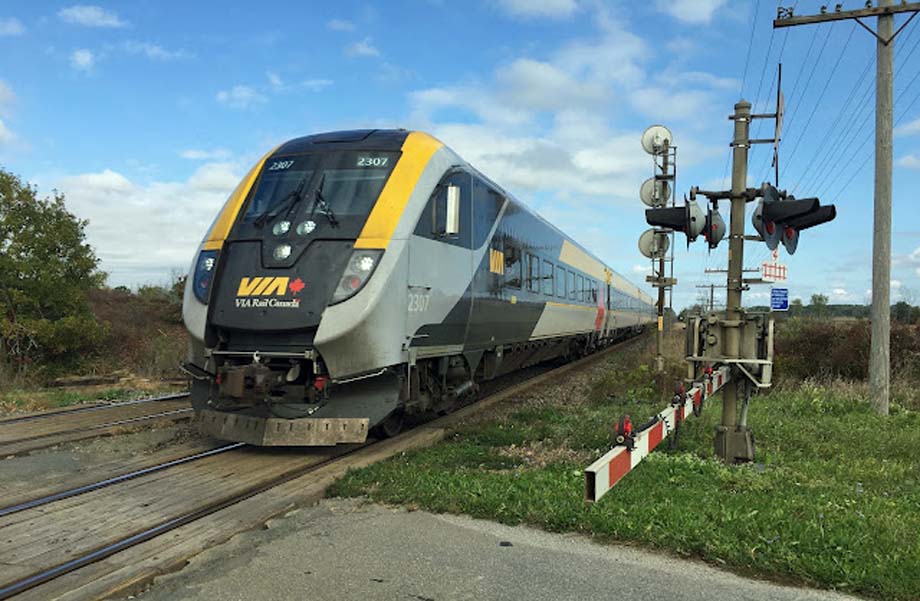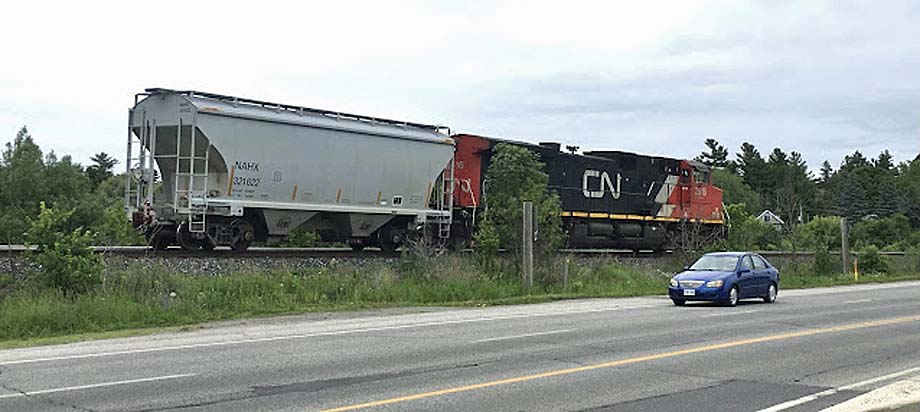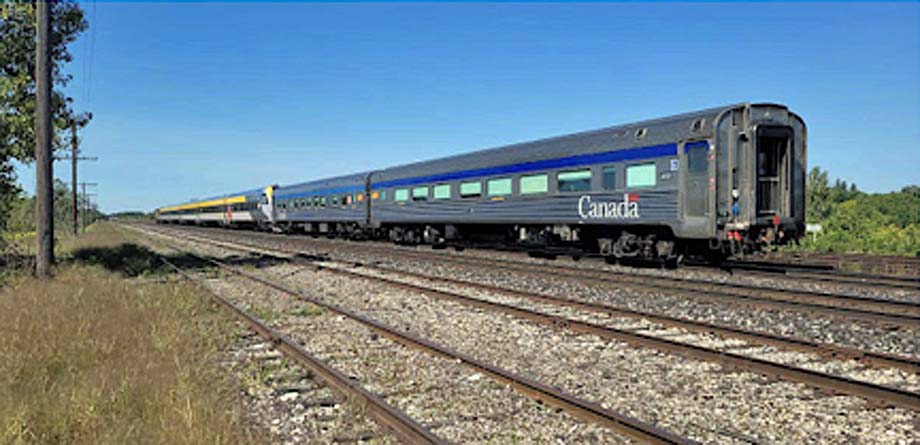
Canada - Yesterday, VIA was informed by CN that there may be safety issues with Siemens Venture trains not shunting properly.
This post will explain why I've used the term Buffer Car in the post title.
Let's Talk About Shunt
In September, 2023, there were issues in the US with various Amtrak trains not properly shunting track (loss-of-shunt) to trigger warning signals at level crossings.
Addressing why Superliners were required on the Illini-Saluki route, the company asserts, "Due to the safety concerns, CN required either the use of heavier equipment, or lowering the maximum operating speed at grade crossings for single-level equipment on this route. This was the responsible thing to do to ensure safe operations."
The speed restriction does not apply with Superliners, which were found to consistently shunt the circuit.
Events occur with the combination of consistently trued wheel profile, lightweight equipment, and minimal axle counts are present.
It is false to claim it only happens on some routes, as any route with these aspects present would likely result in random loss-of-shunt events.
This appears to be a problem that only CN is experiencing, largely due to the design of its signal system.
Other railways' signal system designs don't suffer from the same drawbacks.
CN requires a minimum of 12 axles for track-speed operation of a movement.
That explains this odd assemblage I observed back in June, the shortest freight train ever!

Actually a deadhead movement of a spare locomotive to assist a freight train, and a freight car plucked out of Belleville yard and tacked on the tail-end got it there faster, at close to track speed.
VIA just released the following document, which references a CN document entitled "Venture Equipment Crossing Supplement" which is available to CN employees operating on the Great Lakes and Champlain Districts, under CN Timetables and Special Instructions.
Here is the text of the VIA document:
VENTURE EQUIPMENT - RULE 103.1(f) ON CN TERRITORY
Our host railway, CN has issued restrictions on our Venture fleet related to a potential risk of short warning times on crossings equipped with Grade Crossing Predictors (GCPs). Such crossings utilize technology to estimate your train's speed to determine a sufficient warning time for vehicular or pedestrian traffic. While we continue to work with all stakeholders to resolve this issue as soon as possible, we must convey these restrictions.
The first priority, as always, is the safety of your train. We understand these conditions will introduce additional distractions and competing priorities. We must ensure we remain focused at all times to comply with these restrictions. VIA understands and anticipates that significant delays may be experienced and wants to reaffirm our expectation that our crews will take their time to ensure no restrictions are missed.
CROR Rule 103.1(f): When advised by special instructions that rusty rail or other conditions may exist, occupancy of crossings with automatic warning devices must be manually protected unless it is known that warning devices have been operating for at least 20 seconds.
The VIA Venture Crossing Supplement can be found online.
We are also working to provide paper copies of this document at all reporting locations (Additional bullet points below):
- All trains in possession of a General Bulletin Order instructing you to comply with the Venture Equipment Crossing Supplement must comply with these restrictions at all specified crossing locations;
- At this time, the restriction only applies to Venture trainsets with less than 32 axles. Mixed consists and those consisting exclusively of Legacy equipment (LRC/HEP/Renaissance) equipment are not affected;
- We can't just add more Venture cars. Due to existing reservations and planning constraints, we are limited in our ability to extend trains on short notice. That said, we are doing all we can to minimize impact through all available means;
- The document refers to a shunt enhancer. VIA is actively engaging with suppliers to evaluate and procure these devices. New technology is under development and becoming available to mitigate these risks. At this time, however, we can confirm that no VIA Rail Venture trains are equipped with shunt enhancers;
- These restrictions were not communicated to VIA in advance, and we continue to exhaust all avenues to resolve this issue as quickly as possible. VIA's commitment to safety remains steadfast and we will work with all stakeholders to address any safety concerns.
Shunt Issues Elsewhere - Amtrak and CN
In mid-August, 2023, the latest instalment of an ongoing series of tests was staged out of Canadian National's Effingham yard in southern Illinois.
The sessions, attempting to seek a permanent solution for locations where loss-of-shunt issues are ongoing, were attended by participants from CN, Amtrak, the Federal Railroad Administration, the Illinois and California transportation departments, and equipment vendors.
At that time, CN said that extensive testing had indicated that the random loss-of-shunt detection events experienced by single-level passenger equipment on CN lines in the US was due to the absence of sufficient contact area between the wheels of passenger trains and the rail head.
The wheel profile of a passenger car has a smaller contact area, which CN says contributes to loss-of-shunt.
The smaller contact area on the wheel profile of passenger equipment, combined with short and light trains, prevents systematic sufficient transmission of current necessary to activate fully operational and FRA compliant railway crossings.
Current testing involves an antenna based system.
The latest round of tests investigating ways to ensure trains always activate track circuits, the process known as "shunt", involves shunt-enhancing antennas mounted on both trucks of a state-owned locomotive in Amtrak service in California.
Let's Talk About Shun Some More
How can this still be a problem after all the trains operating on many railroads for decades, including lightweight RDC's, Turbo trains, and other trains with single-level equipment?
I suspect the lawyers were involved and crossing gates must work 100 percent of the time.
If I'm driving over a level crossing, even 99 percent is not good enough.
Who can forget VIA's operational challenges during the ADtranz Flexliner demonstration period in 1996-1997?
There were early technical problems, signals not being activated due to the cars' light weight, which led to a Transport Canada mandated withdrawal from service on 30 Sep 1997.
Flexliner trainsets could apparently "disappear" from dispatcher's computer monitors !
The units were stored until further testing took place in early October.
Composite brake shoes were replaced by steel brake shoes.
You can find further information on this topic on the Amtrak Unlimited Discussion Forum.
A further explanation of shunt from the Railroad Fan discussion forum is useful as well:
Shunt is basically the act of a locomotive, and or rail car, completing (shunting) the circuit in a section of signaled track to show occupancy.
Signal systems are divided more or less into blocks or varying lengths, depending on the territory.
When there is no train in a block, the block will show as "clear".
When a train enters the block, the wheels and axles bridge the gap between the 2 rails, completing the circuit and showing that the block is occupied.
The act of the wheels and axles completing the circuit is called shunting.
Why is this important?
Well, if a train loses shunt, or shunts intermittently, that can create lots of problems for the signaling system.
Lineside signals, crossing protection, every warning device relies on block occupancy and shunt to function properly.
Passenger equipment is on average, much lighter than freight equipment, and can lose shunt more easily.
This is why railroads like CN and CSX have imposed minimum axle counts in passenger trains (usually 20 axles or more), because they were having issues with passenger trains failing to shunt signals and or crossing protection.
This is also the reason why railroads usually limit single light engine moves to 30 mph or less, as a single locomotive moving faster than that can run the risk of losing shunt.
This has happened with single locomotives running light in an approach-lit signal block.
The locomotive lost shunt and the signal actually shut off for a few seconds before flicking back on.
There are various technologies mentioned online, but I'm not enough of a Signals & Communications (S&C) expert to say which ones work, are likely to be implemented, or apply to this current situation.
But that's not going to stop me from wondering what we're likely to see trackside, and whether this will indeed be Buffer Car 2.0?
I have a lot to learn.
The Trainorders site provided excellent information on the evolution of three different technologies involved in crossing circuits:
Old-style AC/DC crossing circuits with insulated joints that acted as an on/off switch.
The train hit the circuit and turned on the protection.
It was fixed and had simple relays.
The insulated joints were marked out to the distance of the fastest moving train speed which set the minimum warning time of about 30 seconds.
So an 80 mph passenger train would have a 30 second warning and a slow crawling freight would have a far longer gate down, or flasher on time, which many times encouraged motorists to go around the gates, or run the crossing.
A very hazardous situation.
Sensors are electronic circuitry that are more advanced than the AC/DC, and sense a train when it hits the circuit controlled by shunts.
Predictors evolved in order to take into account varying train speeds and keeping gate and flasher times consistent so that an 80 mph train and a 20 mph train will have the same warning times.
Predictors are more sensitive than sensors, and if there are problems then they can be switched to sensor mode only, but that gives shorter warning time for fast trains and longer warning time for slow trains.
This is a common thing as sometimes conditions are such that the predictor mode has to be turned off due to false activations.
Turning the current up as mentioned above makes the crossing more sensitive, but also enhances the issue of a false activation, causing more issues.
CN could also add loss-of-shunt timers, or enable loss-of-shunt programming in the predictors.
These features have been built into most predictors since the year 2000.
Siemens makes crossing signal safety products.
Perhaps VIA's Venture sets will have to be equipped with Siemens shunt enhancers.
Shunt enhancers are coils above each rail which induce an electromagnetic field that pushes more current through the wheels and axles, thereby overcoming contact issues and helping along the track circuit current.
How Will This Affect VIA's Corridor Operations
It's interesting that this issue has cropped up in the same week that Venture equipment operated into Southwest Ontario on VIA train numbers 71, 76, 84, and 87 for the first time in regular revenue service.
Could it be a coincidence?
Remember this photo?

In light of recent events, it makes one wonder why it was run.
It remains to be seen how VIA will handle this operationally.
Here are some ideas for VIA:
- Bring every Venture train to a stop for 20 seconds at every such level crossing before proceeding. (20 percent likely, 100 percent effective);
- Manually flag every such level crossing (that's a lot of climbing up and down from the cab!) (20 percent likely, 100 percent effective);
- Don't use Venture equipment. (0 percent likely, 100 percent effective);
- Add additional equipment to Venture consists. (90 percent likely, 100 percent effective);
- ...other creative solutions...watch this space!
Saturday, 12 Oct 2024, noon update: Delays of up to one hour on every schedule are anticipated, as the shunt is about to hit the fan.
VIA passengers with existing bookings are being contacted by email in order to rebook on a connection that builds in the anticipated delays.
(Hmmm, that's just how the initial Buffer Car era was ushered in. Pet owners with existing booking are being told they can't access Fido or Fluffy on the trip because the baggage car is now off limits as a buffer car!)
Guaranteed bookings in the VIA reservation system have been nixed.
Eric Gagnon.
(likely no image with original article)
(usually because it's been seen before)
(the image is altered or fake)
provisions in Section 29 of the
Canadian Copyright Modernization Act.

